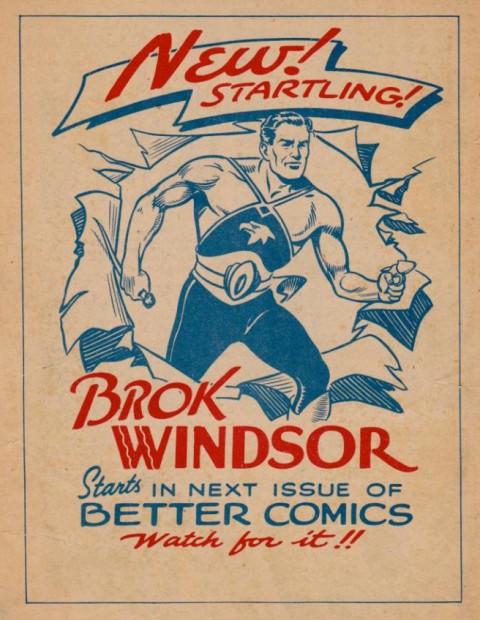
The reprint package of Brok Windsor stories came out last month: Brok Windsor/Jon Stables (edited by Hope Nicholson), Bedside Press, 2015, and is a welcome addition to your Canadiana bookshelf and to your comic bookshelf in general. Overall, this is a much improved effort over last year’s Nelvana reprint collection by Hope Nicholson and Rachel Richey. Hope looks like she has learned a lot from working on the Nelvana book and I trust Rachel’s forthcoming Johnny Canuck reprint book will display similar growth of experience. What follows are some personal impressions concerning this very good effort that shows a promise of more to come.
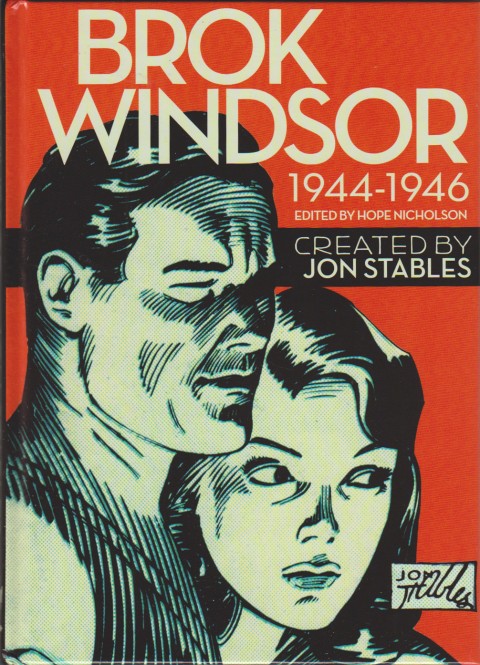
The Nelvana reprint book was a needed and successful production, but it was a first effort. Here, Hope has used the base network she contributed to creating with the Nelvana book to find comic books that are much harder to locate than copies of Triumph Comics and there were a couple of issues of Better Comics which even us hard core Canadian war time comics collectors weren’t sure existed in the run.
The major detraction from the book for me is the choice of cover image which shows a blown-up graphic of the faces of Brok (looking remarkably like Mad Men star Jon Hamm) and Starra from a back cover ad. It just doesn’t want to make me pick up the book and see what’s inside. Brok’s story was an adventure/fantasy, not a romance. There were many impact action cover images (such as Brok grappling with the horned lion from the cover of his first appearance) which would grab the reader more and convey the idea of Brok’s fight for survival in an alien world in an attempt to return home, which is the main thread of the Brok Windsor story. I think this repeats one of the faults of the Nelvana reprint book and when IDW picked up that book it chose to rework the cover image.
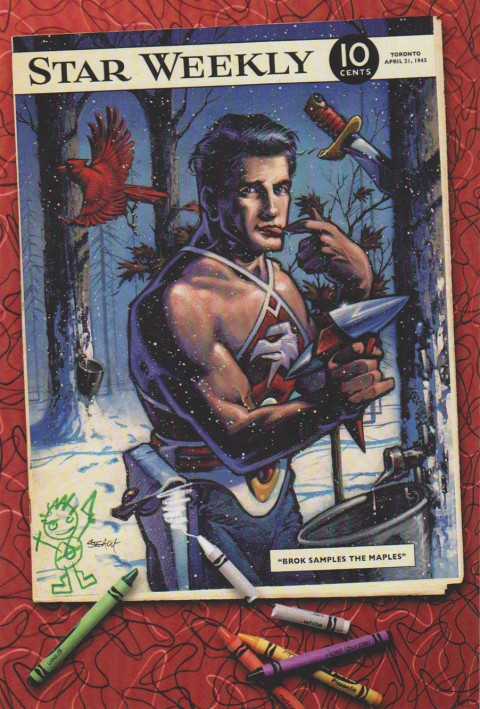
However, this is just the door to a wonderful trip through Jon Stables’ world of Brok Windsor which makes up the more than worthwhile “guts” of this valuable book assembled by Hope Nicholson.
As I’ve said, just finding all the installments is an accomplishment in itself and I’m sure that Hope had to travel right across Canada to locate them. Hope even went beyond this in discovering, in the Ted Ross fonds at the City of Vancouver archives, an unpublished script for the Brok Windsor script that was to appear in sequence after the last published Brok story in the penultimate issue of Better Comics (Vol. 4 No. 37—Brok doesn’t appear in the final issue Vol. 4 No. 38). I wonder if the guillotine hadn’t fallen on those Canadian war time comics that this story would have actually appeared or if Maple Leaf had decided to drop Brok because his strip wasn’t in that last issue of Better Comics.
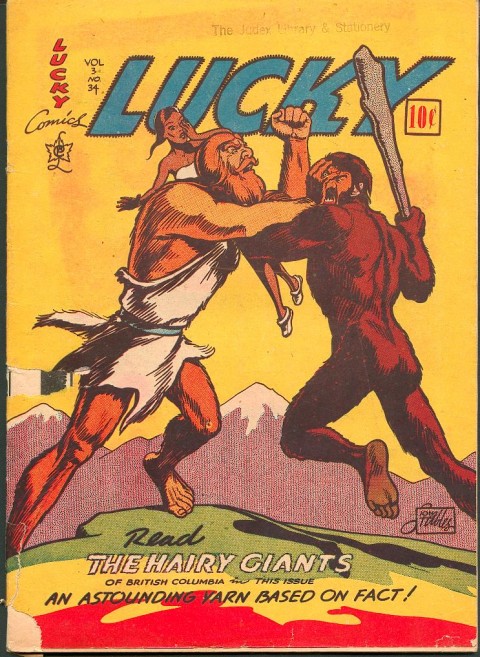
In any event, I think that, in Scott Chantler, Hope found the best artist she could have chosen to realize this script and in my opinion I think that Scott nails it. It’s additions like this, something unexpected and new, that results in a quality reprint book. Similarly the discovery and revelation that Brok was based on a real individual that Jon Stables actually knew in real life accompanied by an account of this real-life Brok by his relatives again enhances the quality of the finished reprint project.
The art in these Canadian war time comics has been and is still often looked down upon as being of lower quality than that found in American comics of the same period, but Jon Stables’ work on Brok Windsor belies this notion. Though I, personally, would not accept Hope’s assertion in her Introduction that “…Brok was the best-drawn Canadian comic book of this era.” Hope of course either meant “feature” instead of comic book (because Brok was never a comic book but only a feature in Better Comics) but to me, even though Stables’ work is outstanding there are a handful of artists such as George M. Rae (RCMP stories and Canada Jack in Canadian Heroes Comics), Howard B. Cowan a.k.a. Clayton Dexter (The Rapier in Top Flight Comics and the later Rex Baxter in Dime Comics), and Adrian Dingle (especially his Sign of Freedom work in Commando Comics) to name some that immediately come to mind.
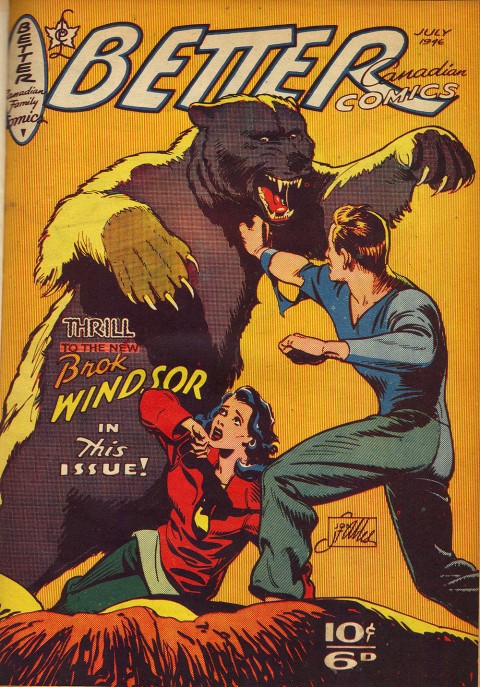
Equally important to the success of a reprint book is a solidly researched accounting of the creator of the character and Hope found the best person to do this in Peter Hansen, who lives on the west coast and has been researching John Stables for a number of years already. Peter’s detailed research uncovers many previously unknown facts about Jon Stables and Peter delivers them to us in a way that demonstrates his love and caring for the subject matter itself (Maple Leaf comics and the creators behind them). At the end of his absorbing piece he ushers in that lament common to all us researchers of these old Canadian comics and the people behind them in wishing we could have started earlier… when many of these creators were still alive.
The book closes with a selection of 25 of the full page Brok Windsor themed commissions that were put together as part of the original Kickstarter campaign for the book and a list of the names of those individuals who contributed to it. These interpretations are always a treat to see and in their own way bring Brok back to life in terms of the modern comics community.
We have to thank Hope for taking on this huge task and pulling it off so well and I look forward to her next effort which I understand will include some of the female Bell Features heroes such as The Wing and Fred Kelly’s Betty Burd as well as Rachel Richey’s next project on reprinting Fred Kelly’s Doc Stearne/Mr. Monster stories.
If you are interested in the obscure history of Canadian war time comics, or if you just enjoy a well-drawn fantasy adventure, pick this collection up. Those interested in ordering online can do so through Bud Plant or Bedside Press.
I thought it would be appropriate to share this interview I did with Jon Stables son Jon back in September of 2013.
IK: When and where did your father die.
JS: He died on the last day of the last century, he made it within a few hours of the new millennium and he died here in Anacortes, Washington.
IK: Your dad and mother got married in Winnipeg on May 15, 1942. You were born June 26, 1946 in Vancouver while your brother Thomas was born on January 26, 1954 in Seattle.
JS: That’s right.
IK: By 1949 your father uprooted the family and moved to the US when you were about three.
JS: Yes, that was the first time. He tried a few times. He had problems like a number of people did in those days with their political affiliation. He’d done some work for some left leaning publications and it caught up with him. He moved to the States in the beginning of 1949 and he’d find some work somewhere, then the authorities would catch up with him and we’d have to go back. So we were back and forth a bit.
IK: When he moved to the Sates was he looking for the same kind of work he’d done in comic books in Canada during the war?
JS: My dad was like so many of them when the comic book industry collapsed in Canada after the end of the war. He was very disappointed and even though he’d done many things before he began doing the Canadian comics, he really loved the comic stuff and he wanted to continue. When we left Vancouver in 1949 we went right down to California and he took a portfolio of his drawings to the Disney Studios and made a big pitch down. One of these things was “The Man in the Mushroom Hat” but nothing came of this with Disney.
IK: Do you remember when all this back and forth to the States stopped and the move became permanent?
JS: Let me think… that must have been around 1957 or 58…
IK: That makes sense. I found a document that supports this. It’s a “Petition for Naturalization” to the U.S. for John Stables from 1958. The curious thing about it though is that, at the bottom of the page there’s a space for the applicant to choose the name he officially wants to be known by in the States and your father wrote “John Brok Stables.”
JS: Well, like many of us, he didn’t have a middle name and my mother thought that that was undignified or “lower class” or something or other so she urged him to do that before the courts when she found out that he could do it at no charge when he got citizenship here. In any case, he did that and he chose the name “Brok.” And he’d already given my brother Thomas the middle name “Brock” which was after a chap he’d known from his days in Winnipeg and which was also a basis for the name of his comic book character.
IK: Now even though your father had a great affection for his comics work he did do so much art as well in order to make a living. Can you tell us about that?
JS: Well, he was always producing something. He did an oil portrait of himself when he was just 12. He did so much newspaper work, ad work, and magazine work in Winnipeg before moving out to Vancouver in 1942. He actually did some sculpture. He sculpted out of clay. I think he did a few things that were cast. He didn’t do metal work… he didn’t weld, but he carved and sculpted and did work in all kinds of media such as water colors. He quit doing oils because my mother complained about the smell. But he worked in acrylics later and he did a bit of abstract art and, although he really didn’t care for it, it sold well. He did portraiture and he did landscapes and he loved drawing animals and human figures. So he produced a lot of stuff and it was so varied. Every now and then when I still used to know people up in Canada and I’d go up to visit, I’d go into somebody’s house and I’d see one of his paintings up on the wall–things that were sold before I was born or done when I was a young child.
IK: Now your dad has come to be regarded as one of the best artists in that period of Canadian war time comics and he is one that we now set up as an example that the work in those old Canadian comics was first rate and could compete with any of the American comics of the time. Was your father ever aware of the way we look back on his comic art?
JS: Mmm… I don’t know, but I’ll tell you one little window I’ve got on that. My dad was very bitter about what happened to the comics industry in Canada. He really liked being in the comic profession. He thought that was teriffic. You know he loved the writing as well and the comics let him do both. So he loved the whole thing and was very unhappy when the industry collapsed. I think he didn’t talk about it much because it was something he really didn’t want to think about which seemed a shame to me.
IK: Can you tell me anything about his work method when he produced an illustration or a page. Was he a fast worker, did he use reference materials, did he prefer any special tools…?
JS: He was a fairly fast worker but he was meticulous and he did use reference materials. He was always out sketching and sometimes he’d turn the thing into a painting and that would become a reference for something else he’d be working on. He’d have me cut things out of magazines and he had hordes an files of stuff for reference. I can’t say that he had a favorite tool because he loved to work in a variety of media.
IK: Did your dad ever go into comic book shops or attend comic conventions or anything like that?
JS: No, no. He didn’t even like to have shows of his own work. Instead he liked to have people over to see things and if they liked something he’d say “Fifty bucks” or something like that. My mother was always the promotion force behind him. She was always trying to get him to have shows, but when he would, they weren’t very well organized and he just didn’t enjoy them. He just wanted to paint. He was one of those pretty single-minded guys and that’s what he did, that’s what he thought and lived and breathed. He was a painter. When he got old his vision started to fail and he was very unhappy about that. He spent over a year on his last painting. He worked on it as much as he could. He worked on it for maybe half-an-hour when the light was just right and then he’d come back to it the next day or the next week. He finally finished it and then, within a couple of weeks, died.
IK: That’s so sad…
JS: Yeah… but he did what he loved to do for such a long time and not everyone his age could do that.
IK: How do you think your father would have looked back on his whole career in art if he had a chance to do this?
JS: Well… I’d say that he knew he was fairly accomplished at his craft and if you were to ask him, I’m sure that he’d say that he was a fair hand at what he did. I think in his own mind, he’d succeeded in fulfilling his main ambition which was to become a good artist and painter but I also know that he would have appreciated more recognition. But in the end what he lived for was to paint and he managed to do that right up to the end of his life. Though he did attend formal classes at times, he was basically self-taught and had art in his blood right from the beginning. This was his calling in life, though it didn’t always go smoothly and he wasn’t always able to make a good living at it.
IK: if I were to ask you what was the one thing that you think of when you think of your dad, what would you say?
JS: … I’d think of his… appreciation of beauty… especially visual stuff but that’s probably not fair because he loved music as well. It would be his awareness of the world what he would see in it.
IK: Finally, can I ask you how you would like to have your dad remembered by every one?
JS: [Pause]… Well, I guess as a person who followed his dream, even though he didn’t have a formal education (he finished school after grade 9) and even though he didn’t have the easiest road to get to where he wanted to go, he did it!!
Jon also sent me a couple of interesting paragraphs about his dad in an email that belongs being shared here as well:
It’s a long time ago, and my dad was always working on many different projects, many of which came to naught. One of my persistent memories is of him working nights at his drawing table (which, along with his easel, is now collecting cobwebs in my garage) and the next morning going out the door lugging a large leather portfolio. It contained both finished work to be delivered and preliminary sketches and notes on new ideas he was trying to sell.
He would return, often with a little money, and always with reports on his adventures with discerning worthies who bought his art and short sighted philistines who showed him the door. He did talk about other artists he visited and corresponded with, both past and present, schemes for collaborations and new possibilities like writing for television and developing techniques for lowering the production cost of animated features. If only I could remember the details, I would be a much better source of information on your topic.
Around the same time that I did the above interview with Jon Stables’ son, I also submitted a request to Canada Post for a 2016 commemorative stamp issue that would mark the 75th anniversary of the first Canadian comic book, Better Comics Vol. 1 No. 1 (March, 1941). See my old post on this. Last week I received a form letter reply which I have altered so that it fits on one page and I’ve reproduced this letter below. It’s a shame but understandable that Hydrangeas win out over Nelvana, Johnny, Brok and the rest of the crew.
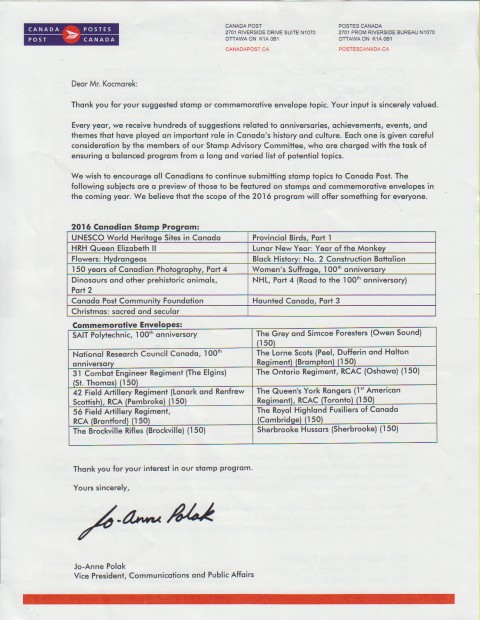




It was the cover image that attracted me to the book: that Alex Raymond style linework is compelling, and to my eyes has no notion of romance. Every big action hero in that era had a damsel at his side.
I found the reproduction quality excellent, with clear and clean artwork throughout. I was surprised by the smaller dimensions of the book, and spoke about it with Nicholson at TCAF. She explained the artwork was reproduced at the same size as the original comics, with the original’s wide margins removed.
While the cover art might have been on a back cover ad (which one?) it was on the front cover of Better Comics V7_3 from Dec-45/Jan-46
I think it’s a great cover that will draw the eye of buyers of the book.
Jon Stables did an amazing job from the front to back of Maple Leaf books from the day he got there beyond just the stories he did.
Thanks for your voice on this, Scott and I know you know your reprint and art books. Mine is just a personal opinion having followed the whole series of stories and seeing some of the other central images of the saga. Thanks also for the info on the size. I knew there was something odd about it but couldn’t put my finger on it.
Of course you are right, it was a front cover image and again mine is just a personal opinion. Let’s see if IDW picks it up and if they do anything with the cover. I can’t agree with you more about the overall stamp of quality that Stables placed on the Maple Leaf comics he worked on is unmistakable and further corroborated by the fact that he was made art director during the last year. Clearly, he is among the best cartoon/comics artists that Canada has produced. It’s sad that he couldn’t latch on in the States doing the same thing in the late forties. Perhaps he should have headed to New York City instead of trying to establish himself on the west coast.
I have just bumped into you guys and thought I would make a comment.
Back in the 1970s the National Gallery of Canada circulated ‘Comic Art Traditions in Canada 1941-45’ based on the Bell Features material acquired by the guys who later founded Nelvana Animation Studios. I had it booked for my gallery (The Dunlop in Regina) for January of 1974. But being a westerner I thought that Canada was more than just Toronto as represented by Bell. I found in the City Archives of Vancouver a treasure trove of material earlier and better than the Toronto stuff. I sought and got permission to add the material from Vancouver to my NGC exhibition. This was unheard of in those days. But the Vancouver was clearly superior to Bell and Anglo-American and those guys in Montreal.
Hi Wayne, Ivan I just read your piece about the Brok Windsor book by Hope which is a terrific effort and tenacity on Hope’s part to not only make it happen but to also redress the balance that Wayne alludes to regarding the East v West comic scene. I sincerely hope that every Canadian who is a fan of comics buys one! Despite being a die hard Maple Leaf Comics fan however I have to say that I think it is a mistake play up the best of the West versus the best of the East. It’s an argument that cannot be won 🙂 For proof just look at the DC versus Marvel argument 🙂 I think both sides had artists and writers who produced quality work and artists who produced some terrible stuff. . It’s interesting to read that Wayne plundered the City of Vancouver Archives in the 9170’s, which would had I known have saved me a lot of time back in the early 90’s when I started off on the trail of Maple Leaf Comics. I found the archive after a couple of years of digging around in the 1990’s, so I have to say that Hope was the third person not the first to reach Everest. 🙂 and if she’d asked for my references I would have told her about the archives.
Peter:
I contrived a wonderful answer to your nice comment but alas it disappeared. So I must start again.
Firstly you must understand that a curators role is to judge. This is better than that. This explains that. You should see this. And back then “you should see this” was really important. The 1970s was in large part uncovering Canadian history by artists and curators. And popular culture attracted many of us in the art world. We were fans who took it seriously. As a curator it is my job to say one is better than another. And many have agreed with me. An argument to be won? Read Marvel Comics: The Untold Story by Sean Howe. Or be old enough to have lived through the period.
Phil Fry did the Graphic Narrative show on Steranko at the Winnipeg Art Gallery. Perhaps the first semiotic look at Comics, which closely followed my ground breaking exhibition on the history of pinball that set attendance records across western Canada
in all the art museums of the day. Mentioned by the organizers of the Windsor Comic Con last fall amazingly as the first time guest Steranko had been back in Canada after 40 years. Who knew any one even remembered that great event? I tried to get Phil to go with me for a bit of old time fun with a guy we respected back then but alas just not a go.
I did not “plunder” the City of Vancouver Archive, it was just simple research and widely known. The donor was a long term NFB employee whose collection was widely reported on in the 1970s.
There are some guys in the Hamilton area who got some attention in The Spectator about Canadian B&Ws a while back suggesting they where the first to think about about war time Canadian comics. Lost and forgotten? No.
No, Fry’s collection has gone to the National Archives as will mine. Bell’s work is widely known.
Thanks for the clarification Wayne, hopefully the Canadian White’s collection in the National Archives will eventually enjoy as much favour in the importance to Canadian culture as the Algonquin schools “The Group of Seven”.
Well, the time frames are decades apart.
Some of the Group worked at The Grip doing advertising art is not equivalent to regulatory conditions creating a comic industry that thrived during the war years.
These are two different worlds. And not equivalent.
But not to say they can each contribute to the story of Canadian history.
Thanks for your insightful comments Mr. Morgan. I first became aware of the existence of West coast Canadian wartime comics when I read a letter to Maclean’s Magazine in late 1971 in response to an article on Bell Features comics that had appeared in the magazine a couple of weeks earlier. It was by Ted Ross, who I believe is the source of the Maple Leaf repository at the Vancouver City Archive. His tone was indignant when he wrote:
Your story on Canada’s wartime comics prompts me to say that once again the West has been shafted by the comical East. As ex-editor of Maple Leaf Publishing Co., I’d like to point out that here in Vancouver we also had our heroes in four different comics and we were on the stands prior to Cyril Vaughan Bell. Ottawa’s National Gallery, please take note.
I didn’t actually hold one of these comics in my hand for another 30 years and the production quality was indeed better, in general, than most of the comics from the East. This unwarranted neglect of West coast war time comics is more due to their scarcity and they are prized additions to any collector’s holdings when they do turn up. This neglect and rift is being redressed constantly as we go along and Hope’s book and Peter’s research are big steps in this direction.
Mr. Morgan, I applaud your initiative in including some of these Maple Leaf comics in the umbrella installation of the travelling exhibit and, indeed, I wish I could have been in the audience at the time. I wish I could have participated in the discourse with the public you must have established with that exhibition.
I do, however, take some small issue with your assertion that the Vancouver comics were better. I’ve had the opportunity to read 75% of the 750 or so Canadian wartime comics from all the publishing houses and I’d certainly hesitate to dismiss the comics from the publishers in central Canada in the same quick way you have done. I do think you are right in the role of curator as “connoisseur” to share your aesthetic sensibilities with the public but not to be dismissive of that product of the central Canada publishers.
I do love and admire the work of Jon Stables, Bert Bushell, Ernie Walker, Shirley Fortune and, my favourite Maple Leaf artist Bus Griffiths, but, to my knowledge, except for late comer John MacKillop who worked on the “Lucky” features in the last few issues, established any sort of fine art career after the comics. In Montréal, both George Menendez Rae and Sid Barron (who established his in Vancouver) had solid fine art careers. At Bell Features there were Adrian Dingle, Oscar Schlienger, Jack Tremblay, Gerald Lazare, and Ross Mendes who went on to have wonderful fine art careers and who all taught art at a high level. Even Anglo-American, with its generally nameless stable of artists, had Harold Town for a while.
Mr. Morgan, thank you for sharing your valuable and expert insight and thank you for all the work you’ve done in bringing popular art into Canadian aesthetic discourse. I assure you that the contribution of those West coast wartime comics are being and will further be pulled into our own Canadian comic book discourse as we learn more about them. Their quality demands them to be.
Again, please forgive me Mr. Morgan, but I see that in a later comment you stat that “There are some guys in the Hamilton area who got some attention in The Spectator about Canadian B&Ws a while back suggesting they where the first to think about about war time Canadian comics.” Well, I was one of those guys and we never implied that we were the first to think about those black-and-white Canadian wartime comics. The article was about how we had uncovered some original comic artwork from the period by a local Whites artist Aram Alexanian and how that was being shared for the first time. Please see my column from three years ago: .http://www.comicbookdaily.com/collecting-community/whites-tsunami-weca-splashes/aram-alexanian/
Just a quick correction.
Ivan:
I must say that I have had an interesting time in the last year since I bought a copy of Brok Winsor at the TCAF shop at TPL for cheap and signed! I did not know anyone was paying attention to Canadian B&Ws to which so many of us had struggled to find, and research. I did not know anyone was paying attention at such a level.
Since then I have encountered various websites and commentators who are deeply committed to the subject.
You have me at an advantage, Three decades later with so many B&Ws to see and review. We were just discovering our history, trying to make sense of it, make our observations and produce exhibitions about it.
Bringing it to the public was paramount.
What’s really sad Ivan is when Canada Post did do the commemorative Canadian Comic Book Heroes stamps in 1995 no Maple Leaf character from the first Canadian comic book company was featured.not even Iron Man?
Wayne: Thanks for hosting the travelling Whites comics art exhibition at your gallery back in 1974. In was an invaluable contribution to make available what we knew then with the general public and for you to add some of the Vancouver comics to your display made that particular showing so much better and even more valuable. It would be amazing to see what a cross-Canada travelling exhibit of such early Canadian comic art could look like today with all we’ve found out.
Peter: I think that the intention and direction of those 1995 stamps was to direct attention and awareness to some of the most prominent heroes over the five decades or so of Canadian comics up to that point. John Bell was the consultant on this project (Please look at my earlier post on John Bell) and he chose not to go in that direction. Two years ago I proposed a similar stamp issue to commemorate this year’s 75th anniversary of Canadian comics and set Canada Post a complete proposal according to their formulas with a cd of cover graphics from all the Canadian companies to show them the diversity and brilliance of these comics, but they decided to go with the usual pictures of birds, military, and hockey players. They did so much for Superman because of his universal clout but wouldn’t lift a finger to promote our own supermen and women who are half as old as Canada itself.